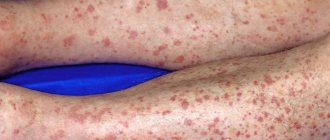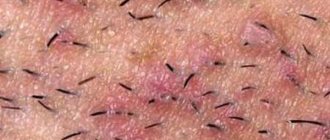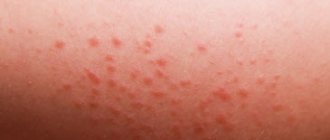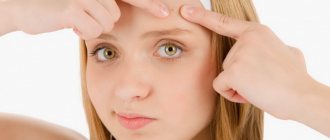Why does acne appear on the face?
Acne (pimples) is directly related to the active work of the sebaceous glands, hyperkeratosis, inflammation and increased colonization of propionibacteria. Excess sebum and dead epidermal cells clog pores, causing open (blackheads) and closed comedones to appear.
An inflammatory process may also begin in the skin, causing papules and pustules to appear. They can either independently or from comedones. Before deciding what to do with pimples* on the cheeks, you need to determine the cause of the rash, and there are several of them [4, 50]:
- Poor nutrition. Consumption of large amounts of fried, spicy, sweet foods, and dairy products increases the functioning of the sebaceous glands, causing rashes.
- Disruption of the digestive system. Allergies to certain foods and metabolic problems can cause rashes.
- Frequent stress and emotional overstrain. During stressful situations, the body produces large amounts of cortisol and adrenaline, which affect the functioning of the sebaceous glands.
- Insufficient or excessive hygiene, use of incorrect cosmetics. A connection has long been established between the appearance of acne and the use of certain types of cosmetics that are called comedogenic. They clog pores, causing acne*.
There are other reasons for the appearance of rashes on the cheeks - heredity, mechanical stress, bad habits, hormonal disorders. Sleeping on one side, using dirty makeup brushes or sponges, and the habit of constantly touching your face with your hands are all triggers for acne.
Pimples* on the face: causes of occurrence in women104
Women's health and skin condition largely depend on hormonal levels. The male hormone testosterone is responsible for the processes that occur in the epidermis. In women, it is produced by the adrenal glands and ovaries.
With increased secretion of androgens, the sebaceous glands begin to produce too much sebum. Gradually it mixes with particles of dirt, dead cells, cosmetics and undergoes oxidation under the influence of oxygen. This is how open comedones are formed.
Hypersensitivity to steroid hormones in women over 30 years of age is one of the main causes of acne. An increase in androgen activity disrupts the water-lipid balance and causes clogged pores. Gradually, against the background of a slowdown in the process of sebum removal, bacteria begin to multiply in the sebaceous glands, and foci of inflammation appear on the skin.
An active increase in the level of androgens and the tendency to form acne is especially pronounced in the second phase of the menstrual cycle. Before the onset of menstruation, the level of steroid hormones in the body sharply increases, which activate comedogenic processes.
How to remove pimples* on the cheeks: treatment features
A cosmetologist or dermatologist can tell you how to get rid of acne* on your cheeks after conducting a diagnosis and determining the severity of the disease. For mild to moderate acne, topical medications are mainly used; with average – complex treatment is necessary; in severe cases, emphasis is placed on systemic therapy [18]. Auxiliary measures may also help:
- correction of diet and getting rid of bad habits;
- refusal of comedogenic cosmetics;
- stress reduction;
- carrying out special cosmetic procedures (peelings, cleansing, polishing).
Regardless of the location of the rashes, it is not recommended to remove them yourself. This can only worsen the condition, and a scar or pigment spot may appear in place of the pimple*.
Pimples* on the cheeks: which organ can hurt?
There is an opinion that there is a connection between the location of the rashes on the face and the functioning of the organs, that is, by the pimples* on the cheeks it is determined which organ is suffering. And this is what the rashes in this zone mean [208]:
- disturbances in the functioning of the stomach (pimples* are located under the cheek line);
- lung diseases (inflammation is localized in the middle and lower parts);
- diseases of the gums and teeth (rashes in the lower part).
In addition, rashes on the cheeks may indicate a lack of positive emotions and lack of oxygen. But there is no scientific evidence that acne* on the cheeks and the functioning of organs are connected.
Problem skin (part 1)
The questions are answered by Tatyana Georgievna Zherlova, PhD, dermatovenerologist, cosmetologist at the aesthetic medicine clinic TG Clinic.
- What tests should be taken to find out the cause of acne?
Tests are prescribed by the doctor after an in-person clinical examination and a thorough history taking; they include: general and biochemical blood tests, hormonal profile (thyroid hormones, sex hormones, etc.), blood test for CSR (Wassermann reaction for syphilis), blood test for parasites, skin culture for pathogenic microflora, etc. At the consultation, the scope of necessary research for each patient is determined.
- Is it possible to determine what the problem is based on the condition of acne and its location on the skin? For example, if there is a problem with gynecological hormones, then where and what kind of acne usually appears?
Often, rashes on the face may indicate one or another problem with the internal organs.
Forehead area
The forehead is the area of the T-zone that is most susceptible to acne. This is due to the fact that a large number of sebaceous ducts are concentrated in this area, which tend to become clogged quickly. Under the influence of hormones, the sebaceous glands begin to work in an enhanced mode, there is a lot of sebum, and it clogs the sebaceous ducts. This is how acne appears.
Therefore, if you are worried about acne on your forehead, it would be a good idea to get tested for testosterone, a hormone that affects the activity of the sebaceous glands. It is also believed that the forehead is a projection of the intestinal sphere. Its upper zone is responsible for the functioning of the large intestine, and the lower part of the forehead is responsible for the functioning of the small intestine. If the rash is localized in the area of hair growth, this is a sign indicating that the gallbladder is not functioning properly.
A rash affecting the center of the forehead is a symptom of problems with the functioning of the gastrointestinal tract. Sometimes pimples can appear directly above the eyebrow area. The reasons for this process lie in the functioning of the heart and bladder.
Often large amounts of rashes on the forehead are the result of a “bad” diet. This is the abuse of fatty and floury foods or sweets. There is an overload of the gastrointestinal tract with difficult to digest food.
It is also worth noting that the forehead area is especially vulnerable to the use of internal medications and hormonal agents. Therefore, acne may appear after taking certain medications.
Rash on cheeks
They have a close relationship with diseases such as intestinal dysbiosis or pneumonia. If the rash is localized in the middle of the cheeks, it is worth checking the lungs. This may indicate an inflammatory process in the respiratory tract. Often acne in this area appears after hypothermia.
Acne on the cheeks can be the result of using low-quality or comedic cosmetics. Some components of cosmetics can clog pores and cause breakouts. Demodicosis (presence of subcutaneous demodex mites) is a skin disease that is also often the cause of rashes on the cheeks.
Rashes on the nose
The nose is one of the most problematic areas on the face. It is not a common site for acne, but open comedones on the nose or “blackheads” are a problem that everyone faces.
The nose is an area of the face where a large number of sebaceous ducts are concentrated. Under the influence of hormones and improper care, they quickly become clogged, preventing metabolic processes in skin cells, which provokes the appearance of rashes. Therefore, the main cause of acne on the nose is the activity of hormones and neglect of daily facial skin care.
Also, according to the rash map, the causes of acne on the nose are associated with the following pathological conditions in the body:
- abnormalities in the functioning of the pancreas;
- stomach diseases;
- cardiovascular diseases;
- inflammation of the bronchi.
Rash on the chin
Associated with oral diseases or hormonal activity. If a person has problems with his gums, then after 1-2 days a small rash may appear in the chin area.
The chin is called the “mirror of the pelvis.” This significance is explained by the fact that this area of the face quickly reacts to problems in the reproductive system. Rashes in the chin area occur when the functioning of the ovaries or appendages in women is impaired, and may indicate the development of prostatitis in men. Therefore, if the rashes are regular, it is worth making an appointment with a gynecologist or urologist, respectively. You should also be checked by an endocrinologist.
In some cases, acne in the chin area appears due to the abuse of strong black coffee or alcohol. Psychological stress is another cause of such rashes.
In women, a rash or conglobate (large) rash in the chin area appears as a result of:
- polycystic ovary syndrome;
- menstrual irregularities.
Rash in the temporal area
They do not occur very often, which is why their appearance alarms many. In some cases, such rashes may indicate serious gallbladder disease. And if they appear regularly, you should consult an endocrinologist.
In addition, acne in the temple area may be symptoms of the following pathologies:
- colon dysfunction;
- avitaminosis;
- disturbances in lymph circulation.
In some cases, acne on the temples appears due to a hormonal surge during adolescence, after childbirth in women, or while taking hormonal medications.
Acne on the bridge of the nose and between the eyebrows
Indicates that the liver is not functioning properly in the human body. The causes of such disorders may be the consumption of junk food or alcohol in large quantities. The liver acts as a blood filter and producer of blood cells - red blood cells. When it cannot cope with the function of purifying the blood, harmful and excess impurities are removed through the surface of the skin. This causes rashes on the bridge of the nose.
Also, the cause of rashes between the eyebrows is nervous tension and frequent manifestations of negative emotions.
Rashes in the eye area
Any skin defects in the eye area (pimples, swelling, beauty, swelling) indicate diseases of the kidneys or adrenal glands. Another common cause is dehydration.
In some individual cases, a rash around the eyes may be a sign of an allergic reaction. Most often, cosmetics act as allergens.
Rash around lips
Associated with disorders of the digestive tract. They may be accompanied by constipation, colic and bloating. Frequent stress, depression and hormonal imbalance are also culprits in the appearance of pimples in the lip area.
A rash with white contents may appear after removal of the “antennae” above the upper lip. This is how an allergic reaction to depilatory products manifests itself.
Thus, based on the location of acne, you can predict the cause of its appearance. But to make an accurate diagnosis, you need to undergo all the necessary types of examination and consult a doctor. It is unacceptable to make a diagnosis on your own based only on the nature of the rash and its location.
The specific localization of the acne area on the face may be associated not only with external irritants. Often the cause of the appearance of a rash in certain areas of the face is diseases of the internal organs of a person.











